The next-gen MacBook Pro with Retina Display Review
by Anand Lal Shimpi on June 23, 2012 4:14 AM EST- Posted in
- Mac
- Apple
- MacBook Pro
- Laptops
- Notebooks
Last year when I wrote about the new MacBook Airs I offered two forward looking paragraphs:
What happens from here on out is what's really interesting. Intel has already committed to moving the TDP of its mainstream parts from 35W - 45W down to 10 - 20W. Since the Air is the new mainstream Mac notebook, Apple has already made that move. The performance in this 10 - 20W segment is going to get much better over the next two years, particularly once Haswell arrives.
The Thunderbolt Display is the first sign of what's to come. Moving IO controllers and expansion into the display, and potentially even moving discrete GPUs out of the notebook are all in store for us. Apple is really ahead of the curve here, but it's easy to imagine a future where laptops become a lot more like the new Air and shift to a couple high bandwidth ports instead of numerous lower bandwidth connections.
Perhaps I was being too aggressive in the prediction of a couple of high bandwidth ports. After all, the next-generation MacBook Pro with Retina Display features four such IO ports (2 x Thunderbolt and 2 x USB 3.0). But you get my point. Gigabit Ethernet and Firewire 800 are both gone. The discrete GPU is still present but I suspect even its days are numbered, at least inside the chassis. The personal computer as we knew it for so long, is changing.
The personal computer is getting thinner, lighter, more integrated and more appliance-like. The movement is no longer confined to just Apple either. The traditional PC OEMs are following suit. Even Microsoft has finally entered the PC hardware business, something it threatened to do for years but hadn't until now. Distribution models will change, the lines between different form factors will continue to blur. What was once a mature industry is going through a significant transformation. It’s exciting but at the same time it makes me uneasy. When I first got into this industry everyone had stories of companies with great ideas that just didn’t make it. As we go through this revolution in computing I’m beginning to see, first hand, the very same.
Apple makes the bulk of its revenue from devices that don’t look like traditional personal computers. For the past couple of years I’ve been worried that it would wake up and decide the traditional Mac is a burden, and it should instead be in the business of strictly selling consumer devices. With its announcements two weeks ago in San Francisco, I can happily say that my fears haven’t come true. At least not yet.
It’s been a while since Apple did a really exciting MacBook Pro launch. Much to my surprise, even the move to Sandy Bridge, the first quad-core in a MacBook Pro, was done without even whispers of a press conference. Apple threw up the new products on its online store, shipped inventory to its retail outlets, updated the website and called it a day. Every iPhone and iPad announcement however was accompanied with much fanfare. The MacBook Pro seemed almost forgotten.
With its WWDC unveil however Apple took something that it had resigned to unexciting, dare I say uncool status, and made a huge deal about it. Two weeks ago Apple did the expected and offered relatively modest upgrades to all of its portable Macs, all while introducing something bold.
Apple calls it the MacBook Pro with Retina Display. You’ll see me refer to it as the next-gen MacBook Pro, Retina MacBook Pro, rMBP or some other permutation of these words.
After using it for the past two weeks I can honestly say it’s the best Mac Apple has ever built. And there’s a lot more to it than hardware.
Portability
If you were hoping for a 15-inch MacBook Air, that’s not what the rMBP is. Instead it is a far more portable 15-inch MacBook Pro. I have to admit I was a bit let down the first time I laid eyes on the next-gen MacBook Pro, it looks good but it doesn’t look all that different. The disappointment quickly faded as I actually picked up the machine and started carrying it around. It’s not ultra light, but man does it make the previous chassis feel dated.
While I never really liked lugging around the old MBP (and it always made me feel like the old fogey at tradeshows where everyone else had something 13-inches or smaller), carrying the rMBP is a pleasure by comparison. Pictures really don’t do it justice. The impressively thin display assembly or overall chassis thickness look neat in a photo but it’s not until you actually live with the rMBP that you can appreciate what Apple has done here. I carry around a 15-inch MacBook Pro because it’s my desktop, and as such it’s incredibly useful to have with me when I travel. For my personal usage model, the Retina MacBook Pro is perfect.
If your workload demands that you need the performance of a MacBook Pro and your lifestyle requires you to carry it around a lot, the reduction in thickness and weight alone will be worth the upgrade to the rMBP. If you spend most of your time stationary however, you’ll have to be sold on the display and internal characteristics alone. The bad news is if the design doesn’t get you, everything else will.

From left to right: 11-inch MacBook Air, 13-inch MacBook Air, 15-inch MacBook Pro, MacBook Pro with Retina Display
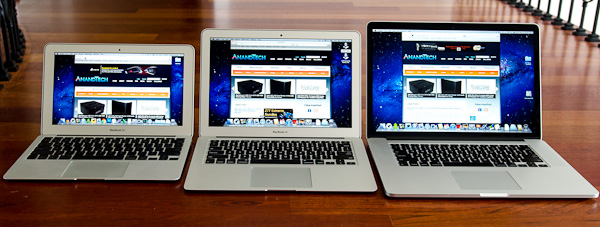
From left to right: 11-inch MacBook Air, 13-inch MacBook Air, MacBook Pro with Retina Display
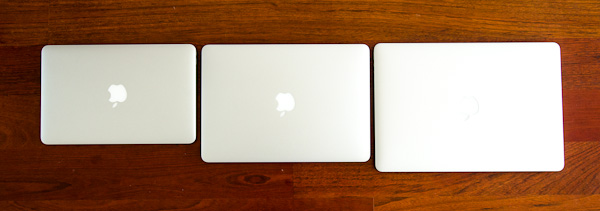
From left to right: 11-inch MacBook Air, 13-inch MacBook Air, MacBook Pro with Retina Display


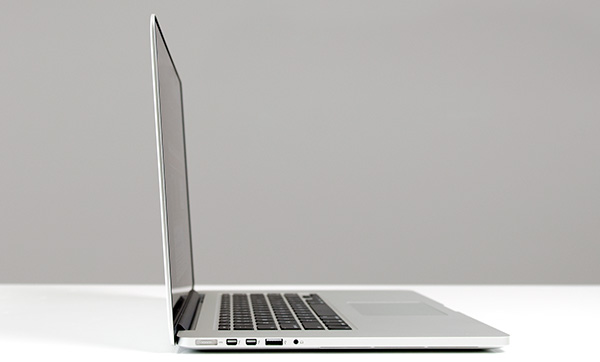
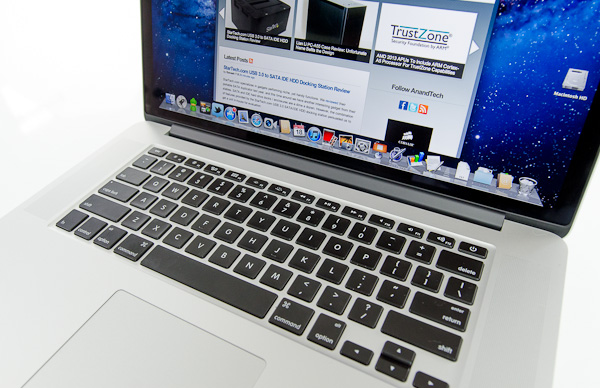
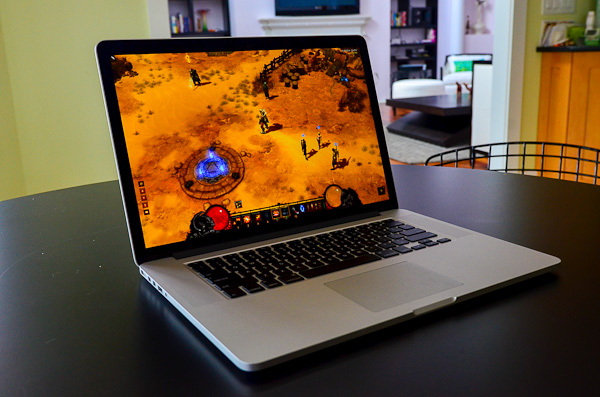
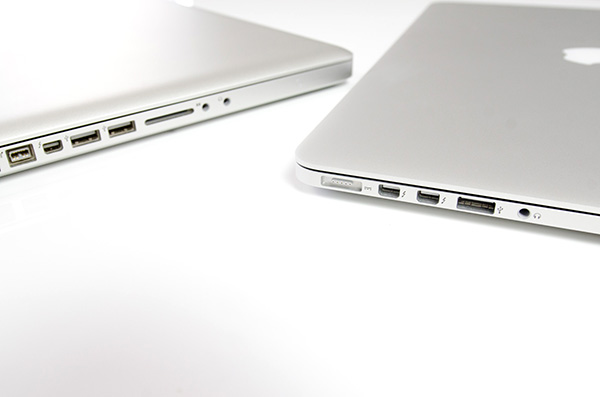
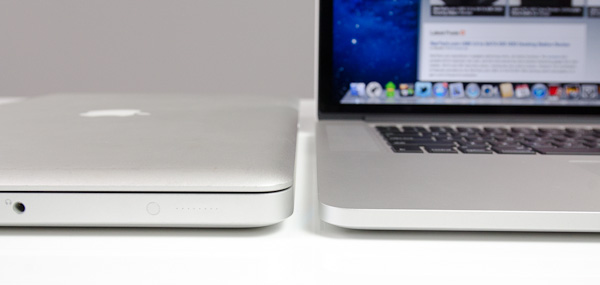








471 Comments
View All Comments
spronkey - Sunday, June 24, 2012 - link
I don't know why people quote this. Who is this "Most People"? The MBP isn't targeted or priced for "Most People".In my personal experience, by far and away the majority of people who own computers end up upgrading *something*, or replacing something out of warranty.
Though, in the lattery category the most common would be replacing a dead HDD, but I don't buy the most people don't upgrade argument. Just look at how large otherworldcomputing is now; and companies like Corsair, Crucial, Kingston wouldn't be producing specific parts for Apple machines if there wasn't a massive upgrade market.
tim851 - Sunday, June 24, 2012 - link
I don't think RAM increases have sped up at all.My major builds over the years:
'96: 8 megs
'98: 16 megs (upgrade)
'99: 128 megs
'01: 512 megs
'03: 1 gig
'06: 2 gig
'08: 4 gig
'12: 8 gig
I don't think most people, including the creative prosumers Apple is targeting, are seeing much use of >4 gigs. 8+ gig configurations have become fairly commonplace recently because RAM has just been ridiculously cheap. I only got the second 4 gig this year because it's been like 30 Euro. Haven't really noticed any of it.
SSDs have taken the pain out of disk swapping too.
Yes, you can cite a lot of anecdotes of people with their multiple virtual machines and huge 4k video projects, but then again Apple has never been trying to satisfy 100% of the market with any product.
felixneo - Sunday, June 24, 2012 - link
maybe not everyone need 8+ GB ram but, for example Adobe Illustrator CS6 recommends 8GB ram on the system requirements page, so i don't know if that qualify as an anecdote, but it sure is the target market for such a laptop. If you don't need more than 4GB ram why you buy a Pro and not an Air? a pissing contest?dtolios - Sunday, June 24, 2012 - link
Its a pissing contest for the VAST (VAST) majority of the MBP buyers, ofc.Vanity is what drives (revenue wise) most high end stuff in Computers, and that is exactly what Apple is about, and made it BIG once they realized who to capitalize on it instead of creativity etc.
Let the romantics and the Jobs is a Saint believers say otherwise.
It's the same in the sports car market (oh, wait, i though all ppl driving around in expensive superfast cars were racing drivers), smartphones (even before the iPhone, but especially after it), the large screen TV, and the clothing industry. It's all a pissing contest, and lucky the few who actually get to distill the innovations to make more innovations out of, thanks to the above contestants paying for things to move forward, even if companies side-step a lot in order to maximize their profits (and not please the crowd, NEVER forget that).
EnerJi - Sunday, June 24, 2012 - link
Screen size, for one. There is no 15" MacBook Air. I'm sure it would sell well if it existed.dagamer34 - Sunday, June 24, 2012 - link
This IS the 15" MacBook Air for all intents and purposes. In fact, that's why I'm almost certain they didn't label the display with the "MacBook Pro" logo. When the other laptops in the lineup get Retina displays, Apple will only be selling "MacBooks". I also expect for the taper to disappear in what we currently call Airs because of the increased battery size needed for the Retina Display. There will also only be one 13" laptop.spronkey - Sunday, June 24, 2012 - link
Actually you just proved my point. In terms of megabytes per year, the trend is close to an exponential increase!Remember - going from 4GB to 8GB is adding more ram in the space of 4 years than you've *ever had in total before*.
We're also starting to see operating systems utilise this more through:
- Caching and prefetch
- Virtualisation
aaand let's not forget what's happening in the browser space - websites are now minature applications with their own requirements on memory.
I'm a software engineer who moonlights as a graphic designer - 4GB isn't enough at all for decent design work - Until I upgraded from 4GB to 8GB early last year, I would often find InDesign and Photoshop eating up all my available memory between them, and 8GB is starting to feel pretty limiting if you want to do a few things with your machine - especially when you start hooking up multiple external displays.
SSDs may take some of the pain out, but things are only going to get worse.
wfolta - Sunday, June 24, 2012 - link
I always use Moore's Law in my plans: a doubling in 18 months. Yes, that's exponential, but when you look at it in terms of "doubling", it's not as crazy as you want to make it out to be.The MBP 17" I was using up until last week had 4GB and that was barely adequate. My rMPB's 16 GB is two doublings, which comes out to 36 months -- 3 years. So in about 3 years, I'll be feeling that 16GB is barely adequate.... except with an SSD I'll actually be a bit better off.
The posting by tim851 shows an increase that's considerably less than doubling every 18 months, which would mean 16 GB would last him even longer than 3 years.
It's a tradeoff: do you want a laptop that's small and light enough to meet Intel's Ultrabook definition, yet it has a screen no laptop can match at any price, a dedicated graphics controller, great battery life, and incredible build quality, with enough RAM that you don't have to worry about upgrading for 3 years or more? Then nothing touches the rMBP.
If you want to trade off several cool feature and slip into the cheapest model machine you can afford, planning on upgrading its components every year or so to keep it acceptable? Then the rMBP's overpriced and inflexible. For you.
spronkey - Monday, June 25, 2012 - link
The point I'm trying to make is that it didn't *have* to be a trade-off. They could have engineered two SODIMM slots in that thing, and a standardised mSATA card. Especially given how much better thermally it is than the previous model...SPLENDEUR - Sunday, June 24, 2012 - link
This was the review I was looking - and waiting - for. It is great that this review goes past the bling factor of the new MBP and goes into the longitudinal nitty gritty.The section regarding Safari performance in this higher resolution, how it jitters during scrolling, was of welcome notice - it has given me a second opinion I needed on whether I should readily buy this (the Retina-populated reviews almost had me!)